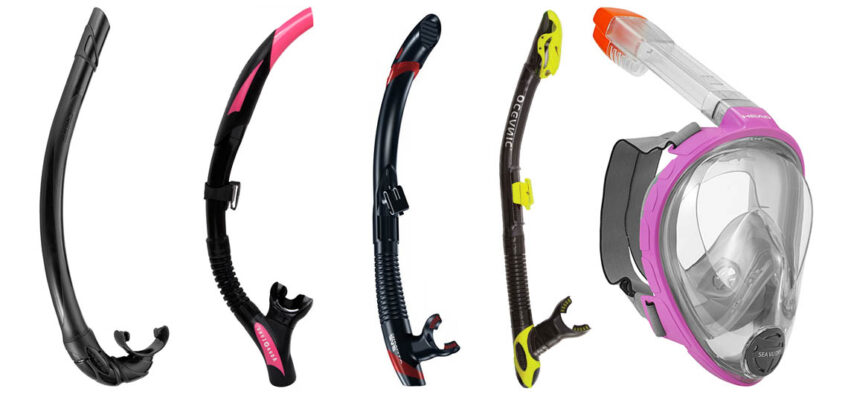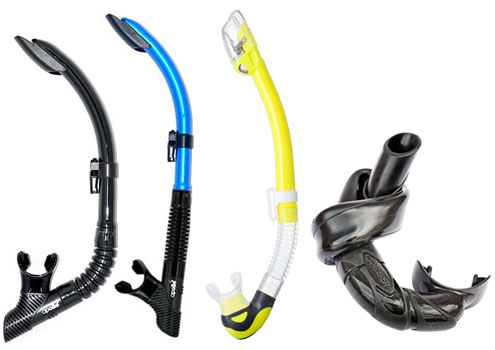
Snorkels, those simple devices that allow us to breathe underwater, are often overlooked in their elegance. Imagine them as oversized, water-friendly straws that have evolved over centuries. In ancient times, hollow reed tubes were our ancestors’ choice, but the concept remains unchanged today.
Today’s snorkels are built for durability, ease of use, and reliability, featuring optimal tube lengths for efficient gas exchange, comfortable mouthpieces, and safeguards to prevent water from invading when submerged or splashed by rogue waves.
In this comprehensive exploration, we delve into the innovations that have transformed snorkels over the years, making snorkeling not only safe but also a delightful pastime.
Understanding Snorkels: A Comprehensive Overview

All modern snorkels share common components: a mouthpiece, the main tube, and a mask clip for attachment to a snorkel or dive mask. Traditional snorkels, often referred to as J-snorkels, consist solely of these elements.
Main Tube
In the past, main tubes were straight, featuring a J-curve only near the mouthpiece. Today’s snorkels have evolved into contoured shapes that ergonomically bend around your face, providing a seamless connection to your mask.
The primary purpose of the snorkel’s main tube is to facilitate the exchange of gases between your mouth and the surface air. This ingenious design allows you to remain submerged underwater while still receiving a fresh supply of oxygen.
However, there are limits to the length of the snorkel tube. Attempting to use an exceptionally long snorkel, exceeding around a foot (or 38cm), poses several challenges. Firstly, breathing becomes more laborious as the air must travel a greater distance before reaching your lungs. This can be particularly taxing for individuals with lung conditions or those lacking physical fitness.
Furthermore, an extended tube increases the risk of inhaling carbon dioxide (CO2) due to the accumulation of stale air within the snorkel. This leads to discomfort and can even result in asphyxiation. Lastly, at greater depths, the increased water pressure hinders the inflow of surface-pressure air, rendering long snorkels impractical for deep-water adventures.
Mouthpiece
Modern mouthpieces are typically crafted from high-quality, soft silicone. This material offers durability and comfort, surpassing traditional rubber alternatives. Silicone mouthpieces are hypoallergenic and easy to sterilize, making them a practical choice. They can also be detached for effortless cleaning or replacement in case of damage.
Most mouthpieces share a common design with two bite tabs for your teeth and a sealing flap that conforms to the inner surface of your lips. High-end mouthpieces may incorporate innovative features, such as bite tabs that mold to your teeth for a custom fit. AquaLung’s Comfo-Bite mouthpieces, for example, boast larger silicone panels that do not require biting down to stay in place.
Determining the proper fit for a mouthpiece is crucial. When wearing one, it should not require excessive biting or lip stretching. Your jaw and lips should remain relaxed, and you should not experience any discomfort. Mouthpieces are typically one-size-fits-all, but smaller options are available for those with specific needs.
Mask Attachment
Snorkels come equipped with mask clips designed for easy attachment and detachment from your mask. Some advanced clips offer pivot functionality for added comfort.
Breathing with a Snorkel Underwater
To use a snorkel effectively while snorkeling, you must breathe deeply to ensure a continuous supply of oxygen. Deep breaths help exchange all the air within the tube, ensuring a consistent flow of oxygen and the removal of carbon dioxide (CO2).
If you ever feel lightheaded or drowsy while snorkeling, it may indicate insufficient oxygen intake. Inadequate deep breathing can cause CO2 to accumulate in the snorkel, leading to the inhalation of stale air and potential asphyxiation. To prevent this, choose a snorkel size suitable for your lung capacity.
Larger individuals may benefit from larger snorkels, while most will find lower-volume snorkels (shorter tube length) ideal. Regular cardiovascular training can also enhance lung capacity and deep breathing skills.
Understanding Classic (Wet) Snorkels
Classic or “wet” snorkels, often referred to as J-tube snorkels, comprise essential components: the main tube, mask clip, and mouthpiece. While some may incorporate purge valves and flexible tubes, these features are standard on higher-end semi-dry and dry snorkels.
Classic snorkels are favored by sports enthusiasts who rely on breath-holding, such as spearfishers and freedivers. Their design emphasizes narrowness, lightweight construction, and shorter lengths compared to dry and semi-dry snorkels. This design ensures efficient air exchange and avoids the problem of trapped air causing unwanted buoyancy within the tube.
Purge Valve
One drawback of classic snorkels is their often minimalistic design, which may lack a purge valve. Purge valves enable water expulsion from the snorkel, typically situated near the mouthpiece. Without a purge valve, snorkelers must manually clear the tube by blowing water out from the top, a skill that beginners may find challenging.
Classic snorkels are best suited for experienced snorkelers who venture a few meters underwater or engage in activities like spearfishing or freediving. Their minimalist, lightweight design appeals to those seeking a slimmer snorkel profile.
Exploring Semi-Dry Snorkels

Semi-dry snorkels bridge the gap between classic snorkels and dry snorkels. In addition to the main components found in classic snorkels, semi-dry snorkels feature flexible tubes, purge valves, and splash guards.
Splash Guard
The splash guard is a molded plastic piece covering the top of the snorkel tube. Equipped with angled slits, it permits air to flow while diverting water away. This design minimizes water ingress from splashes, sprays, rain, or choppy waves, although full submersion can still result in water infiltration.
Purge Valve
Semi-dry snorkels typically include a purge valve, usually located below the mouthpiece in a water reservoir that collects stray water. When you exhale, the valve opens to expel excess water from the reservoir. This feature simplifies tube clearing, making it more accessible for beginners.
Flex Tube
While flex tubes can be found on all snorkels, they are commonly associated with dry and semi-dry snorkels. Although not mandatory, flex tubes offer the flexibility to adjust the mouthpiece’s position for improved comfort. Additionally, they allow the mouthpiece to dangle freely when not in use.
Usage
Semi-dry snorkels find favor among scuba divers aiming to conserve oxygen near the surface without the bulkiness of dry snorkels. They are also popular among snorkelers who enjoy duck-diving while seeking protection against rogue waves. Semi-dry snorkels offer remarkable versatility, making them suitable for various underwater activities.
Whether you’re a beginner or an advanced snorkeler, semi-dry snorkels accommodate a wide range of users. Their dangling mouthpieces provide the convenience of surfacing and taking a breather or communicating with fellow snorkelers without obstruction. Available in diverse sizes and styles, slimmer designs are particularly well-suited for breath-hold activities.
The Intricacies of Dry Snorkels
Dry snorkels encompass all the features of semi-dry snorkels with the addition of a float valve. This float valve is what truly distinguishes a snorkel as “dry.”
How a Float Valve Works
While slight variations may exist depending on the brand and model, all dry snorkel valves operate on buoyancy. When submerged, the buoyant material, known as the float, rises to the top. This float connects to a hinge mechanism responsible for moving a flap that seals and opens the snorkel’s opening.
As you submerge, the float ascends to the top of the tube, effectively sealing the opening before water can enter. Upon resurfacing, the float descends, reopening the tube to allow air to flow freely. This entire process is automatic, eliminating the need for frequent snorkel clearing.
Diving with a Dry Snorkel
While other snorkels require clearing flooded tubes when diving, dry snorkels present their own challenges. As the float valve seals the opening, a residual air pocket remains within the snorkel, introducing unwanted buoyancy. This resistance can affect your diving experience, constantly tugging the snorkel upwards.
It’s essential to clarify that despite the “dry” label, dry snorkels do not facilitate underwater breathing. While you may access a breath using the trapped air inside, prolonged underwater breathing remains impossible.
Dry snorkels excel primarily in surface snorkeling, making them an excellent choice for beginners concerned about accidental water inhalation. However, they tend to be bulkier and heavier than their counterparts.
Full-Face Snorkel Masks
In recent years, full-face snorkel masks have gained popularity. These masks cover the entire face, allowing breathing through either the mouth or nose. Additionally, they feature built-in dry snorkels positioned at the mask’s top. Full-face masks offer a convenient option for beginners seeking an all-in-one solution, negating the need to purchase a mask and snorkel separately.
Conclusion
In this comprehensive guide, we’ve delved into the intricate workings of snorkels, shedding light on their basic components and functionalities. Three primary types exist: classic (wet), semi-dry, and dry snorkels. Each type serves specific purposes, catering to the diverse needs of snorkelers.
While snorkels have evolved to enhance safety and comfort, selecting the right type hinges on your preferences and snorkeling goals. Whether you opt for a classic snorkel for breath-holding activities, a versatile semi-dry snorkel, or a reassuringly dry snorkel for surface exploration, understanding their mechanics empowers you to make an informed choice.
Enjoy your underwater adventures with confidence, knowing that innovation has made snorkeling an accessible and enjoyable pursuit.









